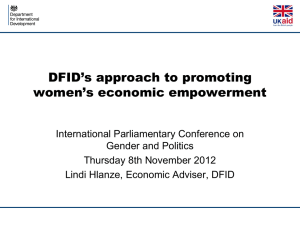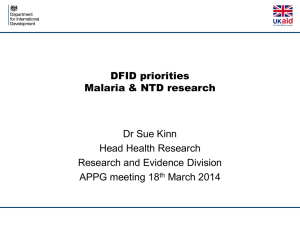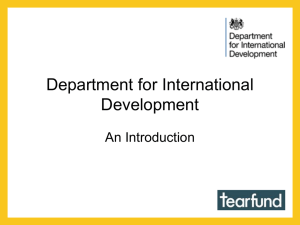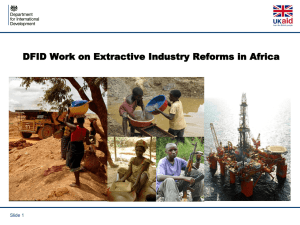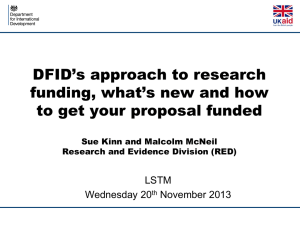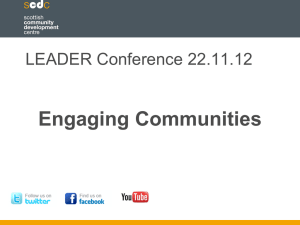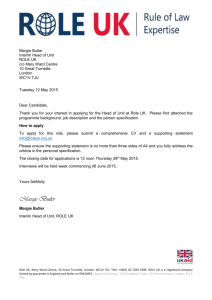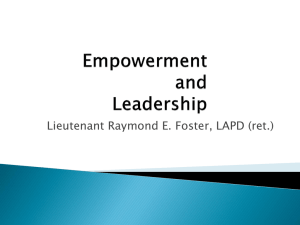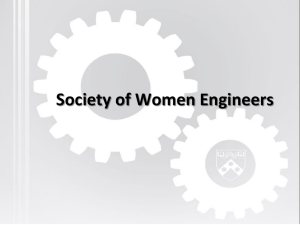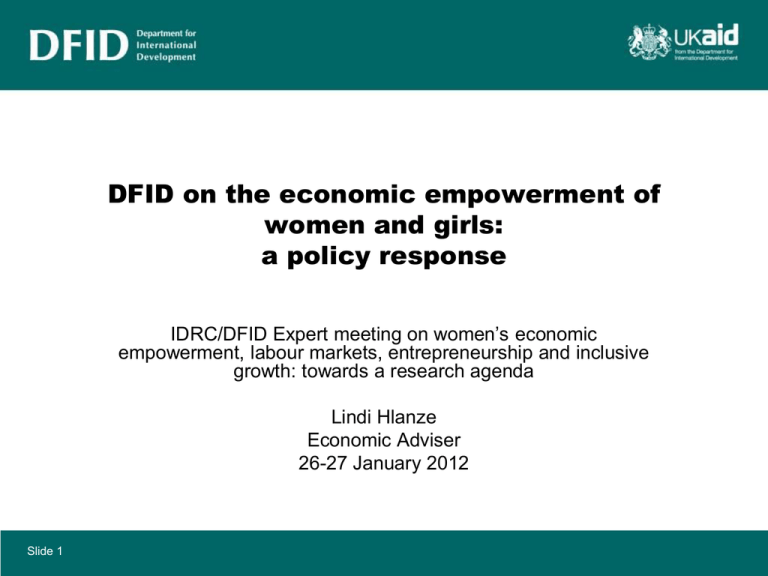
DFID on the economic empowerment of
women and girls:
a policy response
IDRC/DFID Expert meeting on women’s economic
empowerment, labour markets, entrepreneurship and inclusive
growth: towards a research agenda
Lindi Hlanze
Economic Adviser
26-27 January 2012
Slide 1
DFID’s definition of economic empowerment:
Economic empowerment is a process that increases people’s
access to and control over economic resources and
opportunities including jobs, financial services, property and
other productive assets (from which one can generate an
income), skills development and market information.
Slide 2
Why economic empowerment?
• Economic empowerment matters for women and girls – contributing
to their broader empowerment, agency and voice, and to better welfare
outcomes for them, their households and their wider communities.
• It also matters for economic growth – for example, through its impacts
on firm performance, agricultural productivity and generation of tax
revenues.
• There are multiple barriers to accessing resources and opportunities discriminatory cultural and social norms, de facto implementation of
formal or customary laws and regulations, unequal access to resources,
knowledge, information, networks and markets, informality and workplace
discrimination and exploitation.
Slide 3
Economic empowerment of women and girls
•
DFID Business Plan 2011-15: “Recognise the role of
women in development and promote gender equality”
–
One of 6 Ministerial priorities, critical to MDGs
•
DFID Strategic Vision for Women and Girls
1.
2.
3.
4.
Delay first pregnancy and support safe childbirth;
Get economic assets directly to girls and women;
Get girls through secondary school; and
Prevent violence against girls and women.
Slide 4
‘Women account for 50% of informal employment globally’
World Development Report 2012
Get economic assets directly to girls and women
Access to and control of:
• Financial assets (cash, savings, insurance, remittances etc)
• Physical assets (land, property, livestock, productive technologies etc)
Human, social & natural capital critical & complementary
Targets:
• Improved access to finance for 18 million women
• Secure access to land for 4.5 million
Slide 5
Example interventions:
Policy area
Jobs & livelihoods
Training & skills
Property rights
Financial inclusion
Social protection
Enabling
infrastructure
Investment climate
(legal & regulatory
context e.g.
business
registration)
Slide 6
Examples
Women Economic Empowerment for Equitable growth, DFID Tanzania
Making markets work for the poor (M4P), various countries
Punjab job and skills training programme, DFID Pakistan
National Land Tenure Regularisation Roll-Out, DFID Rwanda
Enhancing Financial Innovation for Access, DFID Nigeria
Targeted cash transfers program, DFID Nigeria
Expanding rural access to Water and Sanitation including schools and
clinics, DFID Sierra Leone
Afghan Climate Investment Fund, DFID Afghanistan
Examples of policy-relevant evidence
• Systematic reviews of the evidence base e.g. providing girls and young
women access to economic assets, in low, middle income and fragile
states.
• Independent evaluations of DFID and other programs e.g. the impact of
improved access to water on women’s welfare – how do they spend the
time saved?
• Challenge funds e.g. Responsible and Accountable Garments (RAGS)
– Market-tested evidence
• Case study reviews of M4P programmes without a gender lens
• Evidence-based toolkits e.g. DFID’s Financial Inclusion toolkit and the
World Bank’s Gender Dimensions of Investment Climate Reform
• Business Diagnostics and Dynamics (BUDDY): World Bank tool which
identifies the sources of growth and job creation (data reliant)
Slide 7
Women and work: some reactions
• Need to focus on demand for, more than supply of, labour.
• Reality around informed choice – what should the timeframe
be for this aspiration?
• Pace of change given social norms? How can we bring about
quick but sustainable change?
• How can we address the care economy? Is measurement
and awareness raising enough to bring about change?
• Is growth of the informal sector an inevitable and permanent
trend?
Slide 8
Some policy challenges: Process
• How can researchers engage policy-makers from the outset?
• How can research findings be best packaged and communicated for
policy-makers?
– Graded by quality
– Policy briefs
– Relative value for money of potential interventions (cost versus outcome)
• What types of evidence (including data) are most accessible and useful?
– sex and age-disaggregated data
– ownership versus use of productive assets
Women
account for 60% of the world’s working poor but own less than 10% of the world’s property.
Slide 9
ILO and Commission for Legal Empowerment of the Poor
Some policy challenges: Content
• Can we take a life-cycle/age-segmented approach to research on
women’s economic empowerment?
– WDR: “Investing in girls is smart. It is central to boosting development, breaking the
cycle of inter-generational poverty, and allowing girls, and then women – 50% of the
world’s population – to lead better, fairer and more productive lives.”
• Which sectors should we target? Where can we have the most impact
and engage women in higher value activity?
• How can we ensure that getting economic assets to women and girls
does no harm?
• What time and labour saving technologies could most benefit women and
girls?
• How can we most effectively engage men and boys in this agenda?
Slide 10
Thank you!
Lindi Hlanze
Economic Adviser
(economic empowerment of women and girls)
l-hlanze@dfid.gov.uk
Slide 11

